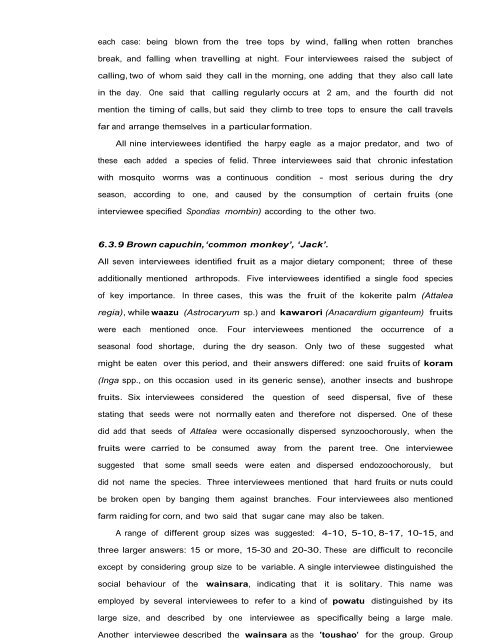Ethnoecology, Resource Use, Conservation And Development In A ...
Ethnoecology, Resource Use, Conservation And Development In A ...
Ethnoecology, Resource Use, Conservation And Development In A ...
You also want an ePaper? Increase the reach of your titles
YUMPU automatically turns print PDFs into web optimized ePapers that Google loves.
each case: being blown from the tree tops by wind, falling when rotten branches<br />
break, and falling when travelling at night. Four interviewees raised the subject of<br />
calling, two of whom said they call in the morning, one adding that they also call late<br />
in the day. One said that calling regularly occurs at 2 am, and the fourth did not<br />
mention the timing of calls, but said they climb to tree tops to ensure the call travels<br />
far and arrange themselves in a particular formation.<br />
All nine interviewees identified the harpy eagle as a major predator, and two of<br />
these each added a species of felid. Three interviewees said that chronic infestation<br />
with mosquito worms was a continuous condition - most serious during the dry<br />
season, according to one, and caused by the consumption of certain fruits (one<br />
interviewee specified Spondias mombin) according to the other two.<br />
6.3.9 Brown capuchin, ‘common monkey’, ‘Jack’.<br />
All seven interviewees identified fruit as a major dietary component; three of these<br />
additionally mentioned arthropods. Five interviewees identified a single food species<br />
of key importance. <strong>In</strong> three cases, this was the fruit of the kokerite palm (Attalea<br />
regia), while waazu (Astrocaryum sp.) and kawarori (Anacardium giganteum) fruits<br />
were each mentioned once. Four interviewees mentioned the occurrence of a<br />
seasonal food shortage, during the dry season. Only two of these suggested what<br />
might be eaten over this period, and their answers differed: one said fruits of koram<br />
(<strong>In</strong>ga spp., on this occasion used in its generic sense), another insects and bushrope<br />
fruits. Six interviewees considered the question of seed dispersal, five of these<br />
stating that seeds were not normally eaten and therefore not dispersed. One of these<br />
did add that seeds of Attalea were occasionally dispersed synzoochorously, when the<br />
fruits were carried to be consumed away from the parent tree. One interviewee<br />
suggested that some small seeds were eaten and dispersed endozoochorously, but<br />
did not name the species. Three interviewees mentioned that hard fruits or nuts could<br />
be broken open by banging them against branches. Four interviewees also mentioned<br />
farm raiding for corn, and two said that sugar cane may also be taken.<br />
A range of different group sizes was suggested: 4-10, 5-10, 8-17, 10-15, and<br />
three larger answers: 15 or more, 15-30 and 20-30. These are difficult to reconcile<br />
except by considering group size to be variable. A single interviewee distinguished the<br />
social behaviour of the wainsara, indicating that it is solitary. This name was<br />
employed by several interviewees to refer to a kind of powatu distinguished by its<br />
large size, and described by one interviewee as specifically being a large male.<br />
Another interviewee described the wainsara as the 'toushao' for the group. Group


